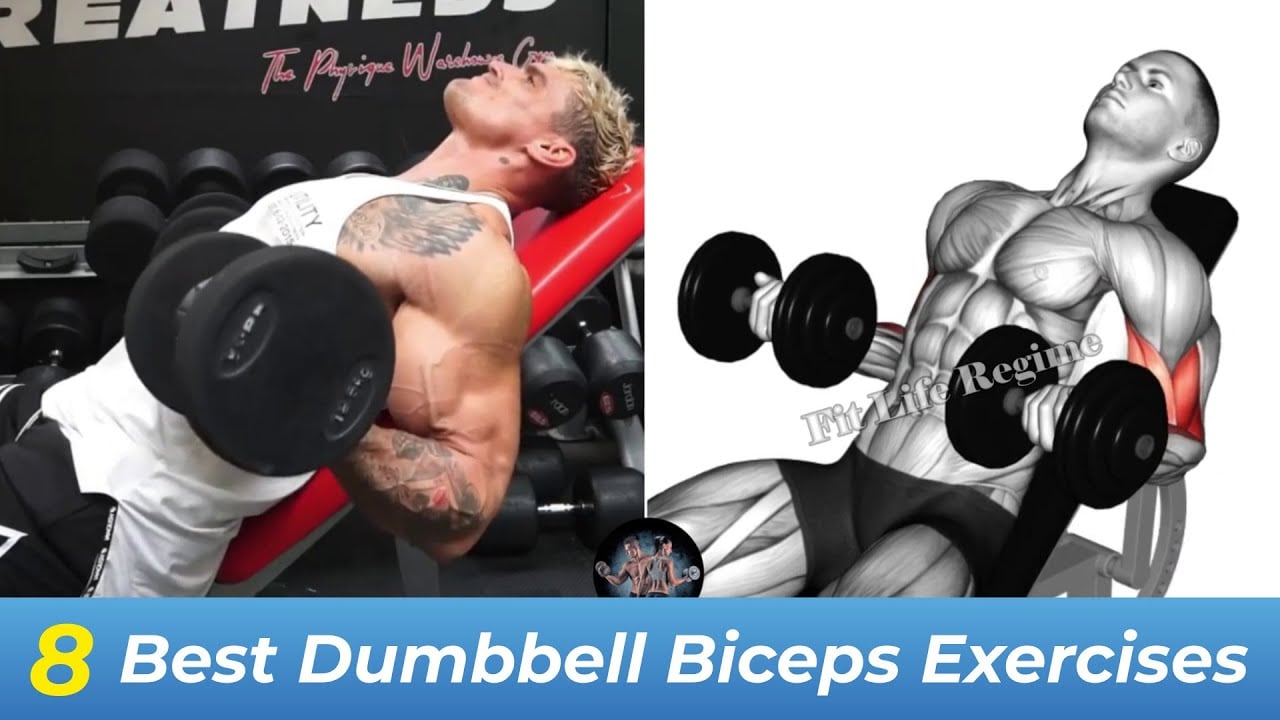If you want to build a bigger and stronger bicep, you should add dumbbell bicep curls to your arm workout routine.
The dumbbell bicep curl is a highly recognizable biceps exercise that helps to build a bigger and stronger arm. It has been used for decades by bodybuilders and strength athletes.
It is a highly effective exercise to target the biceps, brachii, and brachialis muscles.
The standing dumbbell curl effectively isolates and trains the bicep muscles, which promotes muscle growth and definition. They not only build the aesthetic appeal of your arms, but also contribute to functional upper body strength.
There are many variations of dumbbell curl that you can add to your workout routine, and each has its own unique benefits.
- Standing dumbbell Curl: Target overall bicep development. Allow heavier weights for strength gains.
- Dumbbell Seated Curl: Reduce cheating and promote strict form. It is suitable for beginners who have balance issues.
- Alternating Dumbbell Curl: Correct muscle imbalances between arms. Enhance mind-muscle connection.
- Single Arm Curl: Focus on one bicep at a time for increased intensity. Improve grip strength and stability.
Use Our Free Calculator To Know Your Calories Requirement To Gain Muscle Mass
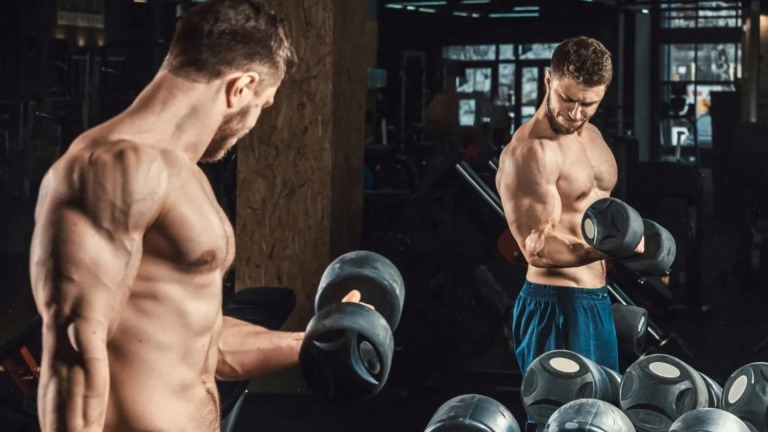
- Dumbbell Curl Muscles Worked
- Bicep Brachii
- Brachialis
- Brachioradialis
- How To Do Standing Dumbbell Bicep Curl
- Dumbbell Bicep Curl Proper Form And Technique
- Variations Of Dumbbell Bicep Curls
- 1. Alternating Dumbbell Curl
- 2. Seated Dumbbell Curl
- Add Dumbbell Curl In Your Workout Routine
- 1. Bicep-Focused Workout Routine
- 2. Pull Workout Routine
- 3. Full Body Workout Routine
- FAQs
- Do Dumbbell Curls Work Forearms
- Is it OK to do dumbbell curls everyday?
Dumbbell Curl Muscles Worked
The dumbbell curl, primarily works the biceps brachii. A handful of other muscles worked or play the role of stabilizer muscles, including your brachialis, brachioradialis and forearm muscles.
The bicep curl has the involvement of several synergist muscles, these muscles include, oblique and core muscles.
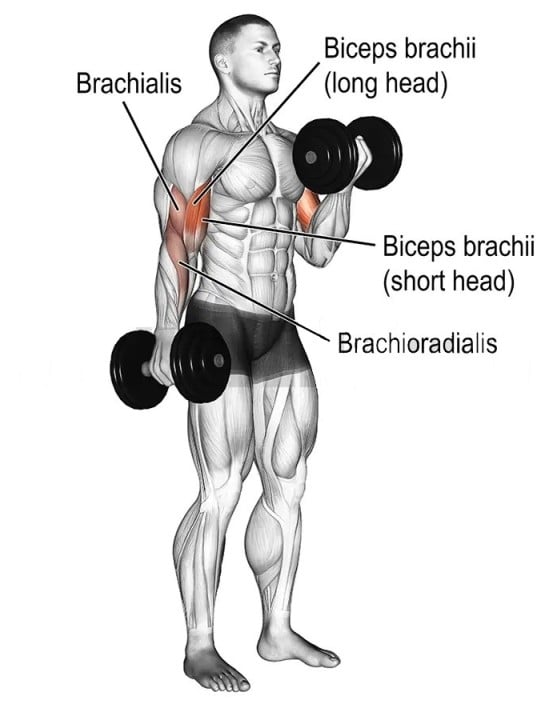
Bicep Brachii
The Biceps is a large, thick muscle of the upper arm. It has two heads: short (inner) and long (outer).
- The short head is located along the inner side of the anterior upper arm. It contributes to the biceps’ width.
- The long head is located along the outer side of the anterior upper arm. It comprises the majority of the biceps’ peak.
Brachialis
The brachialis is a muscle located underneath the biceps brachii. It is primarily responsible for elbow flexion.
Brachioradialis
The brachioradialis is a forearm muscle that runs along the outer side of the forearm. It assists in elbow flexion and plays a secondary role during the dumbbell curl.
How To Do Standing Dumbbell Bicep Curl
- Stand up straight with your feet shoulder-width apart.
- Hold a dumbbell in each hand with a supinated grip (palms facing up).
- Maintain a neutral spine with your shoulders relaxed.
- Exhale and slowly curl the dumbbells up towards your shoulders
- Continue to raise the dumbbells until your forearms are perpendicular to the ground.
- Please take a brief pause and squeeze your biceps at the peak of the movement.
- Inhale as you slowly lower the dumbbells back to the starting position.
- Avoid letting the weights drop or swinging your arms during the descent.
- Keep tension on the biceps throughout the entire range of motion.
- Do 3-4 sets of 8-12 repetitions for each set.
Know More: 15 Best Biceps Exercises With Dumbbells For Mass & Strength
Dumbbell Bicep Curl Proper Form And Technique
- Don’t lift the weight with too much momentum or swing your body.
- Don’t underestimate the pause at the top of your curl, and take a moment to squeeze your bicep when you get there.
- A slow controlled descent will increase time under tension, leading to more effective sets, and less risk of injury.
- Ensure that your elbows are kept close to your sides with your knees slightly bent.
- Always select a weight that allows you to have full control of your body.
- Don’t let your shoulders shrug up towards your ears.
- Incorporate proper warm-ups, rest, and nutrition into your exercise program.
- Rest for 24 to 48 hours before training the same muscle groups to allow sufficient recovery.
- Perform this exercise in a slow, controlled manner for best results.
- Don’t go heavy. Choose a lighter weight and focus on perfecting your form.
- Once you’ve mastered proper form with a lighter weight, you can progressively load by increasing the weight and reps. Start by increasing the weight by 5-10% and reducing your reps to 6-8.
- Select the set, reps, and frequency for the dumbbell bicep curl per your fitness level.
| Level | Sets | Reps | Frequency (per week) |
|---|---|---|---|
| Beginner | 2-3 | 8-10 | 1 |
| Intermediate | 3-4 | 8-12 | 1-2 |
| Advanced | 4-5 | 8-15 | 2-3 |
Variations Of Dumbbell Bicep Curls
There are several variations of dumbbell curls that can target different areas of your biceps and forearms.
1. Alternating Dumbbell Curl
The alternating dumbbell curl is a great variation of the traditional curl. In this exercise, you curl one arm at a time and alternate between the left and right arms.
The one-arm movement enhances the mind-muscle connection and helps you focus on the bicep contractions. It strengthens your neuromuscular connection, which is responsible for major strength gains.
They are also a good option for people who are new to weight training, as they are relatively easy to learn.
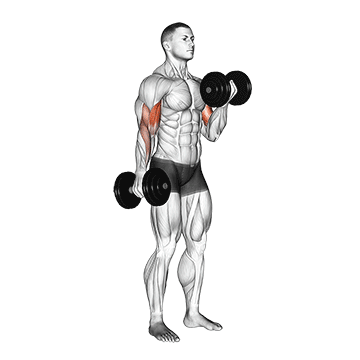
How To Do
- Stand with feet shoulder-width apart.
- Hold a dumbbell in each hand, palms up.
- Curl one dumbbell towards your shoulder, rotating your palm as you lift.
- Squeeze your biceps at the top of the movement.
- Slowly lower the dumbbell back down in a controlled manner, while simultaneously beginning the curl with the opposite arm.
- Continue alternating curls for the desired number of repetitions on each arm.
2. Seated Dumbbell Curl
The seated dumbbell curl is a variation of the classic dumbbell curl, but with an added twist: you’ll perform it while seated on a bench.
The seated position reduces cheating and swinging and allows you to contract the bicep more effectively.
Using a chair or bench provides additional support for your lower back, reducing the strain on this area and allowing you to focus on targeting the biceps.
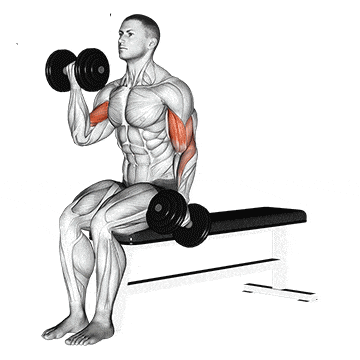
How To Do
- Sit on a bench with your feet planted firmly on the ground.
- Hold a dumbbell in each hand with a supinated grip (palms facing up).
- Bend your elbows and curl the dumbbells up towards your shoulders.
- Squeeze your biceps at the movement’s top, then slowly lower the dumbbells back to the starting position.
Add Dumbbell Curl In Your Workout Routine
The dumbbell curls can be incorporated into your workout routine in various ways. Here are some options:
- As a standalone exercise: Do on 3-4 sets of 8-12 reps.
- As part of a bicep workout: Do 3-4 sets of 8-12 reps along with other bicep exercises like them barbell bicep curl and hammer curl.
- As part of a full-body workout: Do 3-4 sets of 8-12 reps along with other compound exercises like squats, deadlifts, and bench presses.
1. Bicep-Focused Workout Routine
| Exercise | Sets | Reps |
|---|---|---|
| Dumbbell Curl | 3-4 | 8-12 |
| Hammer Curl | 3 | 10-12 |
| Preacher Curl | 3 | 8-10 |
| Concentration Curl | 4 | 8-12 |
| Cable Curl | 3 | 8-12 |
2. Pull Workout Routine
| Exercise | Sets | Reps |
|---|---|---|
| Pull-Ups | 3 | 8-10 |
| Plank | 3 | 8-12 |
| Lats Pulldowns | 3 | 10-12 |
| Dumbbell Curl | 3 | 8-12 |
| Dumbbell Shrugs | 3 | 8-12 |
3. Full Body Workout Routine
| Exercise | Sets | Reps |
|---|---|---|
| Squats | 3-4 | 8-10 |
| Bench Press | 4 | 6-8 |
| Deadlifts | 3 | 8-12 |
| Dumbbell Curl | 3 | 8-10 |
| Overhead Press | 4 | 8-10 |
| Lunges | 3 | 8-12 |
| Plank | 3 | 30 sec |
Know More Daily calories Requirement To Build Arms
FAQs
Do Dumbbell Curls Work Forearms
Yes, dumbbell curls do work the forearms to a certain extent. While the primary focus is on the biceps brachii, the forearms also play a supporting role in stabilizing the weight and assisting with grip strength.
Is it OK to do dumbbell curls everyday?
No, it is not recommended to do dumbbell curls every day. After a workout, your bicep muscles need time to recover and repair themselves. You should allow at least 48 hours of rest between biceps workouts to avoid overtraining and promote muscle growth.
References
- Kraemer & Ratamess (2004) Kraemer WJ, Ratamess NA. Fundamentals of resistance training: progression and exercise prescription. Medicine and Science in Sports and Exercise. 2004;36(4):674–688.
- Differences in electromyographic activity of biceps brachii and brachioradialis while performing three variants of curl
- Staudenmann D, Taube W. 2015. Brachialis muscle activity can be assessed with surface electromyography. Journal of Electromyography and Kinesiology 25(2):199-204
- Biscarini A., Borio R., Coscia F., Mazzolai G., Simonetti S., Rosi G. (2005) Biomechanics of dumbbell, barbell and cable biceps curl exercises. Italian Journal of Sports Science 12, 83-93

Manish is a NASM-certified fitness and nutrition coach with over 10 years of experience in weight lifting and fat loss fitness coaching. He specializes in gym-based training and has a lot of knowledge about exercise, lifting technique, biomechanics, and more.
Through “Fit Life Regime,” he generously shares the insights he’s gained over a decade in the field. His goal is to equip others with the knowledge to start their own fitness journey.

